Patricia Wolfensberger (Translation: Petra Keinhorst and Brendhan Dickerson)
Event #02 – City as a sound-scape.
The second event is dedicated to the city as a sound-scape. A city offers a broad palette of sound experiences. As an immaterial phenomena sound is intangible, difficult to describe. We become aware of it through direct experience only. In every-day life, we tend to concentrate on those sounds we want to hear, or that are immediately useful to us, and filter out the rest. Nonetheless, we are exposed to the remainder every day. Regardless of how our conscious mind filters what we hear, we nevertheless still hear everything subconsciously. This raises a number of questions, particularly in the broad sound-scape of urban space. Which sounds does one choose from the ever increasing sound-cloud of a city? How can we cope with the surrounding sounds more consciously? What are the hidden potentials of sounds? What has a city to offer sound wise? How do space and sound relate to one another? What can we learn and discover from that relationship? The five sound installations each offer their own facetted expressions of space and sound. The second event (Stadt(t)räume als Klangbühne = city spaces/dreams as sound stage) is conceived as a platform for active exchange regarding sound and space. The individual works are intended to evoke questions and discussions, offering a novel approach to a world of sounds.
. . .
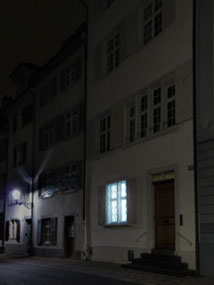
Standing in front of the Markgräflerhof, we can see a light pulsating calmly from a window. It arouses our curiosity by suggesting a life behind it. Light expands into the space outside, and retreats back inside. This calm breathing envelopes us, pulls us into the space like a current. Inside, a curtain in front of an interior partition wall with small windows divides the space. Light falling through the upper partition windows, creates a light beam moving from left to the right across the ceiling, suggesting a vehicle passing by outside. It causes a moment of irritation. Our experiences of inside and outside are inverted. A slight metallic scratching can be heard swelling and shrinking in rhythm with the pulsing light. It resonates on a deeper scale when the light becomes brighter, and thus creates a tension. Entering this room, our previous experiences are turned upside down, and everything seems to dissolve into a mere rhythm of light and sound. We are caught inside the pulsing, 'breathing' light and sound, and become a part of it.
For Christine Camenisch und Johannes Vetsch (both *1956, live and work in Basel), in the installation Generator (2012), the immaterial means of sound and light are motive and experience at the same time. The inside and outside not only intertwines according to the physical position of a spectator, but also in relation to an inner perception, or to apparent spatial-material limitations. Light illuminates, makes visible, projects, expands, transcends, dissolves architectural boundaries, and, in the end lets it all vanish again into darkness. Our perception is questioned and shown to be a projection or illusion the moment we change our point of view. We experience the space as negative or empty through light and sound, only when we breathe with inner light and the sound.
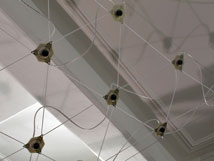
In the hallway, the site-specific installation The Spatial Aural Exciter (2012) of Samy Kramer (*1977, lives and works in Helsinki) consists of a lattice of individual modules networked together. Kramer can thereby adapt and react to each spatial situation he finds. He thus reacts here to a specific occurrence. The contemporary inside passage was once an open alley, of which the lancet arch and the wooden door flaps still remain. Kramer installs his work in an architecture that already interweaves inside and outside spaces, and, with subtle means, transforms the passage environment into an experience of space and sound. The noises of single modules merge with those of adjacent ones, continuously weaving a new sound carpet. These are sounds that we usually exclude from our everyday perception, though they are part of a constantly present sound conglomeration in urban space. Here, they become an intriguing sound-scape, evoking inner images - the chaotic sound flow of a city centre perhaps, or the distant rush which rises up a hill. The sounds change subtly and suggest shifts in the sound carpet, they seem to transform onto the net, causing imaginary movement. Through our movements, we can hear the sound differently, and become active participants in the design of the sound carpet.
The installation "The Spatial Aural Exciter" lets us experience the interaction of sound, space, and movement. It refers to a 'musical' dimension of urban background noises and how they occupy space. The hallway passage transforms to a spatial sound experience, resonating with Kramer's "The way we listen is part of how we see the world".
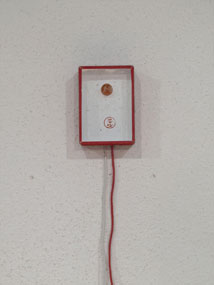
Moving on to the sub-terrain area, descending the stairs, we notice a new sound. At first barely audible, it becomes clearer; a chirp that one can hardly locate. The work Fridolin (2012) by Andreas Frick (*1964, lives and works in Basel) hangs in the centre of a white wall. A small red box with a glass lid draws our attention. It emits a repetitive chirping sound, yet there is no trace of a cricket in it. Only the sound evokes the absence of a cricket, prompting us to seek traces of an erstwhile living creature. The small box encompasses the empty space of what has been, resuscitated by the sound and our imagination. It thus refers to transience and can be read as an "in memory of..." in the here and now.
The work Fridolin originates from Frick's residency in Shanghai. There, crickets are sold in such boxes on the public market. The Chinese keep them as pets in a cage at home, and delight on their melodic chirps. We might experience chirps in our geographical area in nature, whilst in China, it can be found distributed throughout the residential areas. The extent to which crickets and their chirps directly or indirectly represent the lack of nature in a metropolis, is moot.
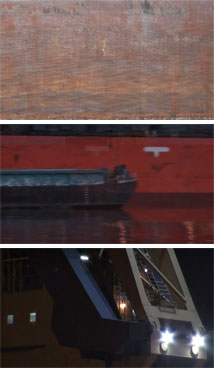
Marco Douma, Roel Meelkop and Rutger Zuydervelt (*1965 Visuals/*1963/*1978 Sound; live and work in Rotterdam) are showing their audio-video installation Pierdie (2012) with which they let us dive into a calm audio-visual atmosphere. The title refers to pier 3 of the Waalhaven in Rotterdam, which is the focal point of their recordings.
An 18 minutes loop shows us the pier recorded throughout one day until the dawn of the following morning, showing the different atmospheres throughout the 24 hours. The recordings alternate between distant views and close-ups, and are woven into abstract, atmospheric images. Soft sounds that were recorded over a distance of water, which dims the hardness of metallic sounds, contribute to a calm, soft atmosphere, just as much as the slow moving camera. They create a meditative and atmospheric sound-image of the harbour which poetically interweaves different aspects of pier3: symphonies of calm moving, heavy metal machinery; huge cranes rotating proudly for the close-up; water reflections transforming to abstract painting. Yet there are irritations despite the meditative tone, be it when a mirror image blurs with the image of the original, or when a u-boat like shape seems to emerge from the waters, showing its eerie sides. Pier3 takes us on a ride through the harbour in time and space, a journey through our associations, intertwining them visually-acoustically to a new level of experience and understanding of this urban zone.
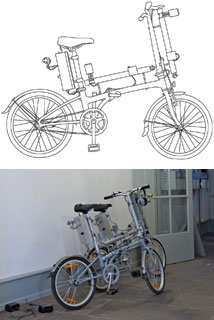
Florian Tuercke (*1977, lives and works in Nürnberg, Germany) offers us a different kind of journey with his two folding Audio-bikes which turn a city tour into a unique acoustic experience in public space. Equipped with microphone and headset, each bike can operate in two different modes. While cycling, the active mode picks up shakes and vibrations and conducts them to a casing that houses two tuned musical strings. The string vibrations are converted, amplified, and conducted to the headphones. Both horizontal and vertical vibrations are transformed and can be heard separately in each ear. The second mode can be activated when the bike is stationary. It encompasses the noises of the immediate surroundings, which are conducted via microphone and transducer to the strings, and, amplified to the headphones. Chosen sites of the urban environment can thus be experienced in a city-musical kind of way. When cycling on from one acoustic spot to the next, the noises are fully concentrated on the vibrations and sound waves produced by the bicycle.
Tuercke offers us an opportunity to enjoy the public city space as an acoustic sound piece. He has been touring different cities with his Project Urban Audio since 2005, recording city noises with his specifically constructed sound wave conductors. An acoustic archive of diverse urban spaces develops - slivers of space and time.